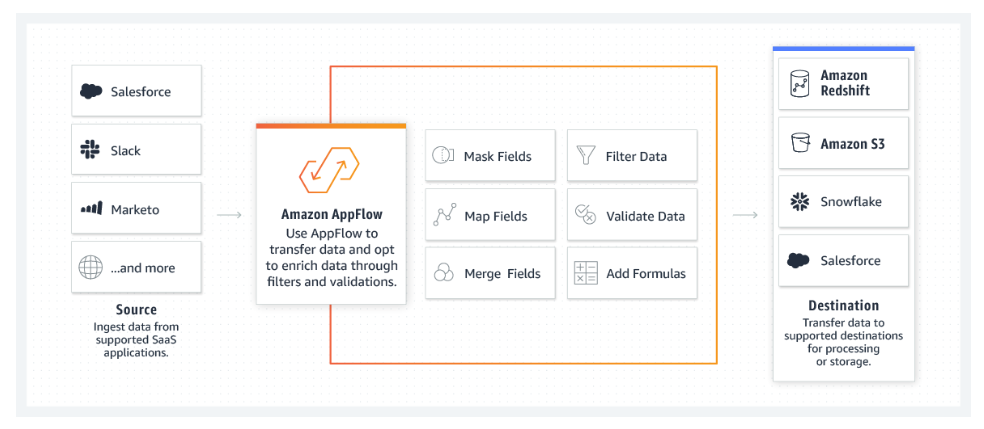What is Amazon App Flow , How it is useful in Aws and Some use cases
 Srikanth Vaddeneni
Srikanth VaddeneniIn this Blog, I will explain the How Amazon app flow service is used how it will be useful and how it can improve business strategies I wrote some Examples in real time With scenarios and I hope it will be useful to recreate your business ideas.
What is Amazon AppFlow?
Amazon AppFlow is a fully managed integration service that enables you to securely exchange data between software-as-a-service (SaaS) applications, such as Salesforce, and AWS services, such as Amazon Simple Storage Service (Amazon S3) and Amazon Redshift.

Understanding Amazon AppFlow:
Amazon AppFlow is a fully managed integration service designed to simplify and secure the transfer of data between AWS and various Software as a Service (SaaS) applications. By eliminating the complexities of managing multiple APIs and connectors, AppFlow empowers businesses to establish connections effortlessly, fostering a smooth flow of information across different platforms.
The following diagram says how you can use Amazon AppFlow to transfer and enrich data from a data source to a data destination in your flow:

Amazon AppFlow enables you to do the following:
Get started quickly — Create data flows to transfer data between a source and destination in minutes, without writing any code.
Keep your data in sync — Run flows on demand or on a schedule to keep data in sync across your SaaS applications and AWS services.
Bring your data together — Aggregate data from multiple sources so that you can train your analytics tools more effectively and save money.
Keep track of your data — Use Amazon AppFlow flow management tools to monitor what data has moved where and when.
Keep your data secure — Security is a top priority. We encrypt your data at rest and in transit.
Transfer data privately — Amazon AppFlow integrates with AWS PrivateLink to provide private data transfer over AWS infrastructure instead of public data transfer over the Internet.
Catalogue your data for search and discovery — Catalog the data that you transfer to Amazon S3 in the AWS Glue Data Catalog. When you catalogue your data, you make it easier to discover and access with AWS analytics and machine learning services.
Organize transferred data into partitions and files — Use partition and aggregation settings to optimize query performance for applications that access the data that you transfer.
Develop custom connectors — Use the Amazon AppFlow Custom Connector SDKs to build connectors for data sources that aren't already integrated with the service. With custom connectors, you can transfer data between private APIs, on-premise systems, other cloud services, and AWS.
Key Features of Amazon AppFlow:
Ease of Use:
- AppFlow boasts a user-friendly interface that allows users to configure and manage data flows without extensive coding knowledge. Its no-code approach makes it accessible to a broad range of users.
Pre-built Connectors:
- With pre-built connectors for popular SaaS applications like Salesforce, ServiceNow, and Slack, AppFlow simplifies integration. Users can establish connections with just a few clicks.
Secure Data Transfer:
- Security is a top priority. AppFlow ensures that data transfers are encrypted, and robust access controls are in place to protect sensitive information.
Automated Workflows:
- Users can create automated workflows to schedule and manage data transfers at specific intervals. This feature reduces manual intervention, enhancing efficiency in routine data integration tasks.
Use Cases of Amazon AppFlow:
Example 1: Salesforce Integration
Scenario:
A company relies on Salesforce as its CRM platform. The sales team captures leads and customer data within Salesforce, and the marketing team uses AWS services for analytics and campaign management
Solution with AppFlow:
Use AppFlow to create a data flow between Salesforce and AWS services.
Map Salesforce leads and customer data to AWS analytics tools, ensuring real-time synchronization.
Enable automated workflows to update AWS analytics with the latest Salesforce information, providing a unified view of customer interactions.
Example 2: ServiceNow Integration
Scenario:
An IT department uses ServiceNow for managing IT services and AWS for cloud infrastructure. The challenge is to synchronize incident data, change requests, and other IT service-related information between ServiceNow and AWS.
Solution with AppFlow:
Establish a data flow between ServiceNow and AWS using AppFlow connectors.
Map relevant ServiceNow incidents and change request data to AWS services.
Implement automated workflows to ensure that updates in ServiceNow are reflected in AWS, streamlining IT service management processes.
Example 3: Marketing Automation
Scenario:
A marketing team utilizes HubSpot for campaign management and AWS for storing and analyzing customer engagement data. The goal is to integrate these platforms for a comprehensive view of marketing performance.
Solution with AppFlow:
Leverage AppFlow to connect HubSpot with AWS analytics services.
Map marketing campaign data from HubSpot to AWS, ensuring a seamless flow of information.
Implement automated workflows to update AWS analytics with the latest HubSpot campaign metrics, enabling data-driven decision-making.
Conclusion:
we've explored how AppFlow can be applied to scenarios involving CRM, IT service management, and marketing automation. Embrace the power of data integration with Amazon AppFlow and propel your business toward a new era of connectivity and productivity.
Subscribe to my newsletter
Read articles from Srikanth Vaddeneni directly inside your inbox. Subscribe to the newsletter, and don't miss out.
Written by

Srikanth Vaddeneni
Srikanth Vaddeneni
Proficient in a variety of DevOps technologies, including AWS, Linux, Python, Shell Scripting, Docker, Terraform, and Computer Networking. I have a strong ability to troubleshoot issues.